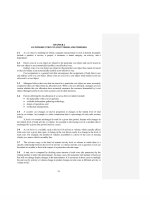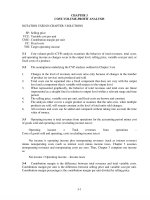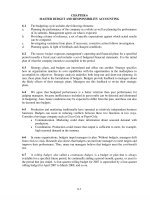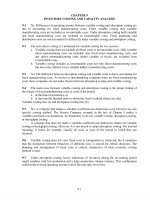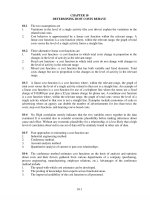Solution manual cost accounting 12e by horngren ch 01
Bạn đang xem bản rút gọn của tài liệu. Xem và tải ngay bản đầy đủ của tài liệu tại đây (260.67 KB, 15 trang )
To download more slides, ebook, solutions and test bank, visit
CHAPTER 1
THE ACCOUNTANT’S ROLE IN THE ORGANIZATION
See the front matter of this Solutions Manual for suggestions regarding your choices of
assignment material for each chapter.
1-1
Management accounting measures and reports financial and nonfinancial information
that helps managers make decisions to fulfill the goals of an organization. It focuses on internal
reporting.
Financial accounting focuses on reporting to external parties. It measures and records
business transactions and provides financial statements that are based on generally accepted
accounting principles (GAAP).
Other differences include (1) management accounting emphasizes the future, (2)
management accounting influences the behavior of managers and other employees, and (3)
management accounting is not restricted by Generally Accepted Accounting Principles.
1-2
Financial accounting is constrained by generally accepted accounting principles.
Management accounting is not restricted to these principles. The result is that
management accounting allows managers to charge interest on owners’ capital to help
judge a division’s performance, even though such a charge is not allowed under
GAAP,
management accounting can include assets or liabilities (such as ―brand names‖
developed internally) not recognized under GAAP, and
management accounting can use asset or liability measurement rules (such as present
values or resale prices) not permitted under GAAP.
1-3
Management accountants can help to formulate strategy by providing information about
the sources of competitive advantage—for example, the cost, productivity, or efficiency
advantage of their company relative to competitors or the premium prices a company can charge
relative to the costs of adding features that make its products or services distinctive.
1-4
The business functions in the value chain are
Research and development—generating and experimenting with ideas related to new
products, services, or processes.
Design of products, services, and processes—the detailed planning and engineering
of products, services, or processes.
Production—acquiring, coordinating, and assembling resources to produce a product
or deliver a service.
Marketing—promoting and selling products or services to customers or prospective
customers.
Distribution—delivering products or services to customers.
Customer service—providing after-sale support to customers.
1-1
To download more slides, ebook, solutions and test bank, visit
1-5
Supply chain describes the flow of goods, services, and information from the initial
sources of materials and services to the delivery of products to consumers, regardless of whether
those activities occur in the same organization or in other organizations.
Cost management is most effective when it integrates and coordinates activities across all
companies in the supply chain as well as across each business function in an individual
company’s value chain. Attempts are made to restructure all cost areas to be more cost-effective.
1-6
―Management accounting deals only with costs.‖ This statement is misleading at best,
and wrong at worst. Management accounting measures, analyzes, and reports financial and nonfinancial information that helps managers define the organization’s goals, and make decisions to
fulfill them. Management accounting also analyzes revenues from products and customers in
order to assess product and customer profitability. Therefore, while management accounting
does use cost information, it is only a part of the organization’s information recorded and
analyzed by management accountants.
1-7
Management accountants can help improve quality and achieve timely product deliveries
by recording and reporting an organization’s current quality and timeliness levels and by
analyzing and evaluating the costs and benefits—both financial and non-financial—of new
quality initiatives such as TQM, relieving bottleneck constraints or providing faster customer
service.
1-8
Planning decisions focus on (a) selecting organization goals, predicting results under
various alternative ways of achieving those goals, deciding how to attain the desired goals, and
(b) communicating the goals and how to attain them to the entire organization.
Control decisions focus on (a) taking actions that implement the planning decisions, and
(b) deciding how to evaluate performance and what related feedback to provide that will help
future decision making.
1-9
The three roles are
Problem solving—comparative analysis for decision making.
Scorekeeping—accumulating data and reporting results to management describing
how the organization is doing and how well it is implementing its strategies.
Attention directing—helping managers to focus on opportunities and problems.
1-10
The three guidelines for management accountants are
1. Employ a cost-benefit approach.
2. Recognize behavioral and technical considerations.
3. Apply the ―different costs for different purposes‖ notion.
1-11 Agree. A successful management accountant requires general business skills (such as
understanding the strategy of an organization) and people skills (such as motivating other team
members) as well as technical skills (such as computer knowledge, calculating costs of products,
and supporting planning and control decisions).
1-2
To download more slides, ebook, solutions and test bank, visit
1-12
The new controller could reply in one or more of the following ways:
(a) Demonstrate to the plant manager how he or she could make better decisions if the
plant controller was viewed as a resource rather than a deadweight. In a related way,
the plant controller could show how the plant manager’s time and resources could be
saved by viewing the new plant controller as a team member.
(b) Demonstrate to the plant manager a good knowledge of the technical aspects of the
plant. This approach may involve doing background reading. It certainly will involve
spending much time on the plant floor speaking to plant personnel.
(c) Show the plant manager examples of the new plant controller’s past successes in
working with line managers in other plants. Examples could include
assistance in preparing the budget,
assistance in analyzing problem situations and evaluating financial and
nonfinancial aspects of different alternatives, and
assistance in submitting capital budget requests.
(d) Seek assistance from the corporate controller to highlight to the plant manager the
importance of many tasks undertaken by the new plant controller. This approach is a
last resort but may be necessary in some cases.
1-13 IMA stands for the Institute of Management Accountants. It is the largest association of
management accountants in the United States. The CMA (Certified Management Accountant) is
the professional designation for management accountants and financial executives. It
demonstrates that the holder has met the admission criteria and demonstrated the competency of
technical knowledge required by the IMA.
1-14 The Institute of Management Accountants (IMA) sets standards of ethical conduct for
management accountants in the following areas:
Competence
Confidentiality
Integrity
Objectivity
1-15
Steps to take when established written policies provide insufficient guidance are
(a) Discuss the problem with the immediate superior (except when it appears that the
superior is involved).
(b) Clarify relevant ethical issues by confidential discussion with an objective advisor.
(c) Consult your own attorney as to legal obligations and rights concerning the ethical
conflicts.
If (a), (b), (c) and other avenues do not resolve the situation, resignation from the organization
should be considered.
1-3
To download more slides, ebook, solutions and test bank, visit
1-16
(15 min.) Value chain and classification of costs, computer company.
Cost Item
a.
b.
c.
d.
e.
f.
g.
h.
1-17
Value Chain Business Function
Production
Distribution
Design
Research and Development
Customer Service or Marketing
Design (or Research and Development)
Marketing
Production
(15 min.) Value chain and classification of costs, pharmaceutical company.
Cost Item
a.
b.
c.
d.
e.
f.
g.
h.
Value Chain Business Function
Design
Marketing
Customer Service
Research and Development
Marketing
Production
Marketing
Distribution
1-4
To download more slides, ebook, solutions and test bank, visit
1-18
(25 min.) Management accounting system and its customers.
1. Management accounting’s customers are managers of departments such as marketing,
production and R&D. Management accounting focuses on providing financial and nonfinancial
information to the managers to help them make better decisions to achieve the organization’s
goals.
2. The value of a management accounting system can be enhanced and, simultaneously,
expectations of managers can be exceeded by providing relevant and timely information to the
managers so that they achieve their strategic goals and make good planning and control
decisions. This means that management accounting must have customer focus. The information
needs of the managers for decision making must be met and exceeded in order to retain them as
users of management accounting information. Management accounting systems should address
the information needs of the managers by helping with problem solving, scorekeeping, and
directing their attention to the following key success factors:
Cost control
High quality
Timely response to customer demand
Innovation
Management accountants have several tools that can help managers concentrate on continuous
improvement of various aspects of their operations.
Value chain and supply chain analysis performed by the management accounting
function can contribute to the achievement of key success factors. When each business function
adds value and all business functions are coordinated and well integrated, it contributes to cost
control, high quality, timely response, and innovation.
1-19
(15 min.) Value chain, supply chain, and key success factors.
Change in
Management Accounting
a.
b.
c.
d.
e.
Key Theme
Value-chain analysis
Key success factors (cost and quality)
Key success factors (cost)
Supply-chain analysis
Key success factors (time)
1-5
To download more slides, ebook, solutions and test bank, visit
1-20
(15 min.) Planning and control decisions.
1. a. Planning—Barnes & Noble (B&N)’s cash needs for the future.
b. Control—B&N’s annual financial performance evaluation.
2. a. Planning—whether to increase or decrease local marketing support.
b. Control—whether recent sales promotion led to an increase in revenues.
3. a. Planning—whether or not to expand B&N’s internet-based lines of business.
b. Control—evaluation by VP of New Business Development of the performance of
managers of individual lines of business.
4. a. Planning—which books to advertise more or which books to include in a special chatroom site.
b. Control—decision by publisher to pay additional bonuses to each author whose book
reaches the bestseller list and stays on the list for a certain period of time.
5. a. Planning—decision by B&N on the amount and type of insurance to purchase next year.
b. Control—follow up by B&N with the insurance company regarding a cash payment to
B&N.
1-21
(15 min.) Problem solving, scorekeeping, and attention directing.
Because the accountant’s duties are often not sharply defined, some of these answers might be
challenged:
a.
b.
c.
d.
e.
f.
g.
h.
i.
j.
Scorekeeping
Attention directing
Problem solving
Attention directing
Problem solving
Scorekeeping (and then attention directing)
Problem solving
Scorekeeping (depending on the extent of the report) or attention directing
Problem solving
Problem solving
1-6
To download more slides, ebook, solutions and test bank, visit
1-22
(15 min.) Problem solving, scorekeeping, and attention directing.
The accountant’s duties are often not sharply defined, so some of these answers might be
challenged:
1. Attention directing
2. Problem solving
3. Scorekeeping
4. Scorekeeping
5. Scorekeeping
6. Attention directing
7. Problem solving
8. Scorekeeping
9. Problem solving
10. Attention directing
1-23
(10–15 min.) Professional ethics and reporting division performance.
1.
Miller’s ethical responsibilities are well summarized in the IMA’s ―Standards of Ethical
Conduct for Management Accountants‖ (Exhibit 1-7 of text). Areas of ethical responsibility
include the following:
competence
confidentiality
integrity
objectivity
The ethical standards related to Miller’s current dilemma are integrity, competence and
objectivity. Using the integrity standard, Miller should communicate unfavorable as well as
favorable information and professional judgments or opinions. Competence demands that Miller
perform her professional duties in accordance with relevant laws, regulations, and technical
standards. Objectivity requires that Miller report information fairly and objectively. Miller
should refuse to book the $200,000 of sales until the goods are shipped. Both financial
accounting and management accounting principles maintain that sales are not complete until the
title is transferred to the buyer.
2.
Miller should refuse to follow Maloney's orders. If Maloney persists, the incident should
be reported to the corporate controller. Support for line management should be wholehearted, but
it should not require unethical conduct.
1-7
To download more slides, ebook, solutions and test bank, visit
1-24
(15 min.) Planning and control decisions, Internet company.
1.
Planning decisions
a. Decision to raise monthly subscription fee
c. Decision to upgrade content of online services (later decision to inform subscribers
and upgrade online services is an implementation part of control)
e. Decision to decrease monthly subscription fee
Control decisions
b. Decision to inform existing subscribers about the rate of increase—an implementation
part of control decisions
d. Dismissal of VP of Marketing—performance evaluation and feedback aspect of
control decisions
2.
Other planning decisions that may be made at WebNews.com: decision to raise or lower
advertising fees; decision to charge a fee from on-line retailers when customers click-through
from WebNews.com to the retailers’ websites.
Other control decisions that may be made at WebNews.com: evaluating how customers
like the new format for the weather information, working with an outside vendor to redesign the
website, and evaluating whether the waiting time for customers to access the website has been
reduced.
1-8
To download more slides, ebook, solutions and test bank, visit
1-25
(30 min.) Problem solving, scorekeeping, attention directing, and feedback,
Internet company (continuation of 1-24).
1.
(a) and (e) Decisions to change subscription fee.
Problem solving—report outlining expected revenues from subscribers and advertising
with different monthly fee amounts.
Scorekeeping—report with monthly subscribers and their revenues in prior months.
Attention directing—report showing the change in the number of subscribers of Internet
companies at the time they change their monthly fees.
(b) Decision to inform existing subscribers of $24.95 fee from July onwards.
Problem solving—report analyzing different ways (e-mail, regular mail) of informing
subscribers.
Scorekeeping—report indicating how many subscribers have been contacted.
Attention directing—report showing how many subscribers have cancelled their
subscriptions following notification of the increase in fees.
(c) Decision to upgrade content of online services and to offer better Internet mail
services.
Problem solving—report outlining expected revenues from subscribers and advertisers as
a result of upgrading service.
Scorekeeping—report with monthly subscribers and revenues before and after upgrading
service.
Attention directing—report showing the change in the number of subscribers of Internet
companies after they upgraded service.
(d) Decision to dismiss vice president of marketing.
Problem solving—report indicating alternative reasons for the slowdown in subscribers
from July to September 2006.
Attention directing—report analyzing growth in subscribers at competing Internet
companies compared to WebNews.com.
Scorekeeping—report showing the number of subscribers after the Vice President of
Marketing was dismissed.
2.
As a result of the feedback from the control system, WebNews.com made the following
decisions:
a. Decision in October to change subscription fee from $24.95 per month in September
2006 to $21.95 in November 2006.
b. Dismissal of Vice President of Marketing after significant slowing of subscriber
growth in accounts and revenues.
3.
WebNews.com overestimated the number of subscribers for the July to September 2006
period. It might examine the methodology it uses to estimate the sensitivity of
subscriptions to price changes and upgrade of its services.
1-9
To download more slides, ebook, solutions and test bank, visit
1-26
1.
2.
3.
4.
5.
6.
7.
8.
9.
(15 min.) Management accounting guidelines.
Cost-benefit approach
Behavioral and technical considerations
Different costs for different purposes
Cost-benefit approach
Behavioral and technical considerations
Cost-benefit approach
Behavioral and technical considerations
Different costs for different purposes
Behavioral and technical considerations
1-27
(15 min.) Role of controller, role of chief financial officer.
1.
Activity
Managing accounts payable
Communicating with investors
Strategic review of different lines of businesses
Budgeting funds for a plant upgrade
Managing the company’s short-term investments
Negotiating fees with auditors
Assessing profitability of various products
Evaluating the costs and benefits of a new product design
Controller
X
CFO
X
X
X
X
X
X
X
2.
As CFO, Perez will be interacting much more with the senior management of the
company, the board of directors, and the external financial community. Any experience he can
get with these aspects will help him in his new role as CFO. George Perez can be better
positioned for his new role as CFO by participating in strategy discussions with senior
management, by preparing the external investor communications and press releases under the
guidance of the current CFO, by attending courses that focus on the interaction and negotiations
between the various business functions and, either formally or on the job, getting training in
issues related to investments and corporate finance.
1-10
To download more slides, ebook, solutions and test bank, visit
1-28
(30 min.) Software procurement decisions, ethics.
1.
Michael faces an ethical problem. The trip appears to be a gift which could influence his
purchase decision. The ethical standard of integrity requires Michaels to refuse the gift.
Companies with ―codes of conduct‖ frequently have a ―supplier clause‖ that prohibits their
employees from accepting ―material‖ (in some cases, any) gifts from suppliers. The motivations
include
(a) Integrity/conflict of interest. Suppose Michaels recommends that a Horizon 1-2-3
product should subsequently be purchased by Fiesta. This recommendation could be
because he felt obligated to them as his trip to the Cancún conference was fully paid
by Horizon.
(b) The appearance of a conflict of interest. Even if the Horizon 1-2-3 product is the
superior one at that time, other suppliers likely will have a different opinion. They
may believe that the way to sell products to Fiesta is via ―fully-paid junkets to
resorts.‖ Those not wanting to do business this way may downplay future business
activities with Fiesta even though Fiesta could gain much from such activities.
Some executives view the meeting as ―suspect‖ from the start given the Caribbean location and
its ―rest and recreation‖ tone.
2.
Fiesta should not allow executives to attend user meetings while negotiating with other
vendors about a purchase decision. The payment of expenses for the trip constitutes a gift that
could appear to influence their purchase decision.
Pros of attending user meeting
(a) Opportunity to learn more about Horizon’s software products.
(b) Opportunity to interact with other possible purchasers and get their opinions.
(c) Opportunity to influence the future product development plans of Horizon in a way
that will benefit Fiesta. An example is Horizon subsequently developing software
modules tailored to food product companies.
(d) Saves Fiesta money. Visiting suppliers and their customers typically cost money,
whereas Horizon is paying for the Cancún conference.
Cons of Attending
(a) The ethical issues raised in requirement 1.
(b) Negative morale effects on other Fiesta employees who do not get to attend the
Cancún conference. These employees may reduce their trust and respect for
Michaels’s judgment, arguing he has been on a ―supplier-paid vacation.‖
Conditions on Attending that Fiesta Might Impose
(a) Sizable part of that time in Cancún has to be devoted to business rather than
recreation.
(b) Decision on which Fiesta executive attends is not made by the person who attends
(this reduces the appearance of a conflict of interest).
(c) Person attending (Michaels) does not have final say on purchase decision (this
reduces the appearance of a conflict of interest).
(d) Fiesta executives go only when a new major purchase is being contemplated (to avoid
the conference becoming a regular ―vacation‖).
1-11
To download more slides, ebook, solutions and test bank, visit
A Conference Board publication on Corporate Ethics asked executives about a comparable
situation. Following are the results:
76% said Fiesta and Michaels face an ethical consideration in deciding whether to
attend.
71% said Michaels should not attend, as the payment of expenses is a ―gift‖ within the
meaning of a credible corporate ethics policy.
3.
The company does not need its own code of ethics. They can use the code of ethics
developed by the IMA.
Pros of having a written code
The Conference Board outlines the following reasons why companies adopt codes of
ethics:
(a)
(b)
(c)
(d)
Signals commitment of senior management to ethics.
Promotes public trust in the credibility of the company and its employees.
Signals the managerial professionalism of its employees.
Provides guidance to employees as to how difficult problems are to be handled. If
adhered to, employees will avoid many actions that are unethical or appear to be
unethical.
(e) Drafting of the policy (and its redrafting in the light of ambiguities) can assist
management in anticipating and preparing for ethical issues not yet encountered.
Cons of having a written code
(a) Can give appearance that all issues have been covered. Issues not covered may appear
to be ―acceptable‖ even when they are not.
(b) Can constrain the entrepreneurial activities of employees. Forces people to always
―behave by the book.‖
(c) Cost of developing code can be ―high‖ if it consumes a lot of employee time.
1-29
(30–40 min.) Professional ethics and end-of-year actions.
1.
The possible motivations for the snack foods division wanting to take end-of-year actions
include:
(a) Management incentives. Gourmet Foods may have a division bonus scheme based on
one-year reported division earnings. Efforts to front-end revenue into the current year
or transfer costs into the next year can increase this bonus.
(b) Promotion opportunities and job security. Top management of Gourmet Foods likely
will view those division managers that deliver high reported earnings growth rates as
being the best prospects for promotion. Division managers who deliver ―unwelcome
surprises‖ may be viewed as less capable.
(c) Retain division autonomy. If top management of Gourmet Foods adopts a
―management by exception‖ approach, divisions that report sharp reductions in their
earnings growth rates may attract a sizable increase in top management supervision.
2.
The ―Standards of Ethical Conduct . . . ‖ require management accountants to
1-12
To download more slides, ebook, solutions and test bank, visit
Refrain from either actively or passively subverting the attainment of the
organization’s legitimate and ethical objectives, and
Communicate unfavorable as well as favorable information and professional
judgment or opinions.
Several of the ―end-of-year actions‖ clearly are in conflict with these requirements and should be
viewed as unacceptable by Taylor.
(b) The fiscal year-end should be closed on midnight of December 31. ―Extending‖ the
close falsely reports next year’s sales as this year’s sales.
(c) Altering shipping dates is falsification of the accounting reports.
(f) Advertisements run in December should be charged to the current year. The
advertising agency is facilitating falsification of the accounting records.
The other ―end-of-year actions‖ occur in many organizations and may fall into the ―gray‖ to
―acceptable‖ area. However, much depends on the circumstances surrounding each one, such as
the following:
(a) If the independent contractor does not do maintenance work in December, there is no
transaction regarding maintenance to record. The responsibility for ensuring that
packaging equipment is well maintained is that of the plant manager. The division
controller probably can do little more than observe the absence of a December
maintenance charge.
(d) In many organizations, sales are heavily concentrated in the final weeks of the fiscal
year-end. If the double bonus is approved by the division marketing manager, the
division controller can do little more than observe the extra bonus paid in December.
(e) If TV spots are reduced in December, the advertising cost in December will be
reduced. There is no record falsification here.
(g) Much depends on the means of ―persuading‖ carriers to accept the merchandise. For
example, if an under-the-table payment is involved, it is clearly unethical. If,
however, the carrier receives no extra consideration and willingly agrees to accept the
assignment, the transaction appears ethical.
Each of the (a), (d), (e), and (g) ―end-of-year actions‖ may well disadvantage Gourmet Foods in
the long run. For example, lack of routine maintenance may lead to subsequent equipment
failure. The divisional controller is well advised to raise such issues in meetings with the division
president. However, if Gourmet Foods has a rigid set of line/staff distinctions, the division
president is the one who bears primary responsibility for justifying division actions to senior
corporate officers.
3.
If Taylor believes that Ryan wants her to engage in unethical behavior, she should first
directly raise her concerns with Ryan. If Ryan is unwilling to change his request, Taylor should
discuss her concerns with the Corporate Controller of Gourmet Foods. Taylor also may well ask
for a transfer from the snack foods division if she perceives Ryan is unwilling to listen to
pressure brought by the Corporate Controller, CFO, or even President of Gourmet Foods. In the
extreme, she may want to resign if the corporate culture of Gourmet Foods is to reward division
managers who take ―end-of-year actions‖ that Taylor views as unethical and possibly illegal. It
was precisely actions such as (b), (c), and (f) that caused Betty Vinson, an accountant at
WorldCom to be indicted for falsifying WorldCom’s books and misleading investors.
1-13
To download more slides, ebook, solutions and test bank, visit
1-30
(40 min.) Global company, ethical challenges with bribery.
1.
It is clear that bribes are illegal according to U.S. laws. It is not clear from the case
whether bribes are illegal in Vartan. However, knowledgeable people in global business would
attest to the fact that it is virtually impossible to find any country in the world that specifically
sanctions bribery. The major point, however, that deserves discussion is: Should ZenTel engage
in any unethical activities even if they are not illegal?
It is difficult to make a generalization about all shareholders of the company. It is,
however, safe to assume that not all shareholders would want to keep their investment in a
company that is engaged in unethical and/or illegal activities. There is historical evidence to
substantiate this point: When apartheid laws were in effect in South Africa, many investors
divested shares of companies doing business in South Africa.
Apart from the ethical issues, it should also be noted that bribery can be very costly in
some parts of the world. Bribes may not generate revenues sufficient enough to offset their cost.
2.
Apparently Hank thinks that local culture and common practice are one and the same.
This, in fact, is not the case. There are many common practices in developing countries, which
are against the native culture.
Specifically, bribery often leads to decisions that are not made on the basis of the merits
of the alternative selected. This results in misallocation of meager resources of the developing
country. Misallocation of resources has adverse effects on the economy of a country and the
living standard of its population. The negative impact is intensified in developing countries
because they can least afford the misallocation of resources.
As it applies to local common practice, multinational companies make some small
allowances but draw a hard line against paying the $1 million ―commission.‖
3.
ZenTel might have an articulated corporate policy against such payments to get the
message across that regardless of laws, the top management would not tolerate any bribery
payments made by its employees. A strong and consistent message from the top often has a
noticeable effect on the corporate culture and employee behavior.
U.S. laws specifically prohibit bribery payments. Such payments can result in heavy
penalties to the corporation making the payments.
4.
If this contract is of great importance to ZenTel’s global strategy, it is likely that this kind
of issue will come up again as ZenTel expands into very diverse cultures and the company
should tackle it head on and make a policy decision against offering bribes. Steve Cheng should
discuss the situation with the top management at ZenTel and re-affirm his goal to get the Vartan
contract with legal means. He could seek the help of the U.S. commercial attaché in Vartan to
continue a dialogue with Vartan’s deputy minister of communications. He could propose other
creative, legal changes to the ZenTel’s bid, even at the cost of reducing the profitability of the
current project. Concessions such as training programs, schools and other public works projects
may be legal, get the attention of the Vartan government and raise ZenTel’s profile both at home
and abroad. In the worst case, if the Vartan government does not agree to any of the creative,
legal ―extras‖ that ZenTel can provide in order to win the contract, Cheng should report this to
ZenTel’s management and be willing to walk away from the Vartan project.
1-14
To download more slides, ebook, solutions and test bank, visit
Chapter 1 Video Case
The video case can be discussed using only the case writeup in the chapter. Alternatively,
instructors can have students view the videotape of the company that is the subject of the case.
The videotape can be obtained by contacting your Prentice Hall representative. The case
questions challenge students to apply the concepts learned in the chapter to a specific business
situation.
REGAL MARINE: The Accountant’s Role
1.a. Preparing a schedule of depreciation for boat hull and deck molds—Scorekeeping.
b. Analyzing the desirability of using standard Volvo-Penta boat engines in a new boat
model—Problem solving.
c. Preparing the daily report of the number of hull defects found during the quality check on
the Sport Boat assembly line—Attention directing and scorekeeping.
d. Explaining the Commodore Yacht Division’s monthly performance report—Attention
directing.
e. Interpreting differences between actual results and budgeted amounts on the monthly
performance report for the prototyping department—Attention directing.
f. Preparing a monthly statement of boat sales, by model and customer, for the company’s
vice president of sales—Attention directing (or Scorekeeping).
g. Analyzing, for the design team, the impact on product costs for a new dashboard odometer
display—Problem solving.
h. Preparing a cost comparison of two plywood manufacturers for use by the purchasing
manager—Problem solving.
2.a. Cost of a toll-free telephone line used for customer inquiries about product specifications,
performance, and warranty coverage—Customer Service, or if prior to purchase—
Marketing.
b. Cost of sales and promotional materials—Marketing.
c. Labor costs of workers in the Cabinetry Department of the production facility—Production.
d. Cost of an industry research report on boat industry trends—Research & Development or
Design of products or processes.
e. Equipment and trucks purchased for transporting finished boats to retail outlets such as the
Boat Tree—Distribution.
f. Boat hull and deck mold fabrication costs—Production.
g. Cost of a new CAD design station—Design of products or processes.
h. Costs of upholstery seats for Commodore yachts—Production.
1-15

